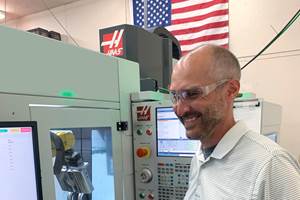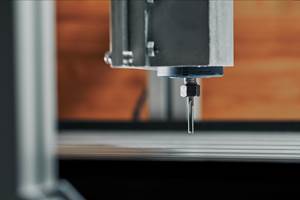Overall Equipment Effectiveness: The Formula For Finding Your Plant’s Hidden Potential
A metric that captures availability, performance and quality highlights the many places where today's automation makes sense. (Sponsored Content)
You may know the cycle time for a given operation, and the extent to which that cycle time has recently been improved. You may know how much time the shop spends to setup a particular part. Most manufacturers are in touch with numbers such as these.
However, what many manufacturers do not know is the real effect of any one variable on the process as a whole. If one aspect of the process is improved—if part of the process is automated, for example—then to what extent does that improvement translate to an improved productivity overall?
In the context of manufacturing automation, the question is particularly important. The options for automating have grown. The easily accessible options today include hardware automation, software automation and the vastly expanded range of decision-making capabilities available to the CNC. What all of these automation tools have in common is that they tie the process more tightly together. They let one step in the process flow naturally into another step, reducing the need for a human being to intervene.
That means the manufacturer evaluating automation needs to look at the total process. That manufacturer needs to know how well the process is working right now, and how much better it will work when a particular automation solution has tied two previously disconnected parts of the process together.
In short, manufacturers need a metric that lets them see the big picture—and measure it.
That metric, the score for evaluating process improvements, is called Overall Equipment Effectiveness. The term is abbreviated OEE.
What Is OEE?
OEE measures how effectively a manufacturer converts its time into output. (The output we are focused on here is machined parts that are acceptable to the customer.)
There are three components of OEE, and each component has two major problem areas. The components are availability, performance and quality. Here is what those terms mean:
- Availability. A manufacturer’s availability is its actual production time as a percentage of its planned production time. Planned breaks and planned downtime are not included in the planned production time, so availability describes only how much of a manufacturer’s planned time is put to use. The two problem areas that cause availability to be less than 100% are setup and equipment breakdowns.
- Performance. A manufacturer’s performance describes how many pieces were produced during that actual production time. Performance is the number of pieces produced as a percentage of the number of pieces expected—according to the manufacturer’s ideal productivity rate for that part. The problem areas that cut into performance are speed reductions and minor stoppages.
-
Quality. A manufacturer’s quality is the number of good pieces as a percentage of the number of pieces produced. The problem areas that compromise quality can be grouped into setup yield and production yield. Each area describes a different set of errors. Setup yield describes the errors that are present from the very first part machined (example: a setup location error). Production yield relates to those errors that creep in during production (such as the error resulting from tool wear).
OEE combines these components. OEE = Availability × Performance × Quality.
A world-class manufacturer might realize an OEE of 85%. (See the table.) Meanwhile, an excellent manufacturer might realize an OEE of 70%, and a manufacturer that is relatively good probably runs at around 50%. For most manufacturers, OEE reveals that there is a lot of potential production capacity going unused.
Why Is OEE Important?
Much more could be said about OEE—the online resources (see below) cover the topic in more detail.
For now, here is the bottom line: The automated manufacturing process of today will apply various types of automation in various ways, addressing the various different components of OEE. The new view of manufacturing automation recognizes that a higher OEE should be the objective—not just some localized improvement.
To understand how different types of manufacturing automation address different aspects of OEE, please keep reading. Articles in this special booklet address robotic automation, automated information management, and also the automation potential to be realized through machine tool measurement—which is the topic of the article that begins on the next page.
|
World-Class OEE Because the score captures so much information about the process, an OEE value can be surprisingly low. The very best manufacturers achieve an OEE just over 85%. Here is how: |
|
|
OEE Factor
|
World-Class Score
|
| Availability Operating Time ÷ Planned Production Time |
90.0%
|
|
Performance
Pieces Produced ÷ (Operating Time × Target Productivity Rate) |
95.0%
|
| Quality Good Pieces ÷ Pieces Produced |
99.9%
|
| OEE Availability × Performance × Quality |
85.4%
|
Related Content
When Handing Down the Family Machine Shop is as Complex as a Swiss-Turned Part
The transition into Swiss-type machining at Deking Screw Products required more than just a shift in production operations. It required a new mindset and a new way of running the family-owned business. Hardest of all, it required that one generation let go, and allow a new one to step in.
Read More5 Reasons Why Machine Shop Ownership Is Changing
Mergers, acquisitions and other ownership changes are an effect of Boomer-age shop owners retiring, but only in part. Also important: The way we think about machining has changed.
Read More5 G-Code Tips for Increasing CNC Efficiency
Optimizing G code is a low-cost way to improve CNC efficiency without sacrificing usability and safety.
Read MoreFive Safety Considerations for CNC Machinists
Safety in CNC environments is essential for users – and for productivity. Consider these 5 points to avoid injury, part failure and downtime.
Read MoreRead Next
The Cut Scene: The Finer Details of Large-Format Machining
Small details and features can have an outsized impact on large parts, such as Barbco’s collapsible utility drill head.
Read More























